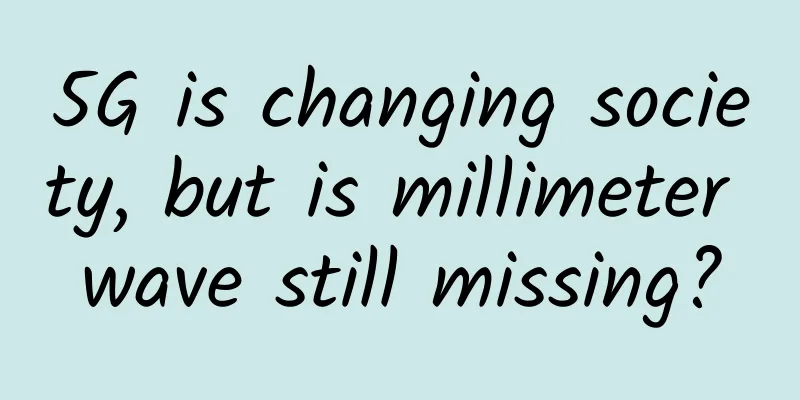5G is changing society, but is millimeter wave still missing?

|
Three years ago, 5G ushered in the first year of commercial use. In three years, 175 operators around the world have begun to deploy 5G. China has handed in a beautiful 5G report card. At present, more than 1 million base stations have been built and the number of 5G terminals has exceeded 420 million. During this period, 5G has enabled more than 6 million netizens to "climb to the top" of Mount Everest, and appreciate the magnificence and steepness of Mount Everest without leaving home. The construction speed of Huoshenshan and Leishenshan hospitals in China has also been witnessed through 5G+ cloud network technology. It is said that "4G changes life, 5G changes society". 5G has indeed appeared frequently in our lives, but ordinary consumers who use 5G mobile phones have not yet felt the unique experience brought by 5G. The advantages of 5G in industrial and medical applications have not yet been reflected. Why hasn’t 5G changed society yet? Why is millimeter wave technology worth looking forward to?
5G applications have broken the ice, but lack of scale effectThe biggest difference between 5G and previous mobile communication technologies is that this generation of technology will no longer only connect people, but will also connect people and things, and things and things. This is also the key reason why 5G can change society. Ma Hongbing, general manager of China Unicom's Technology Innovation Department, said at the second 5G millimeter wave industry summit forum: "The high speed, low latency and large connection characteristics of 5G are not obvious to ordinary consumers. 5G is going to change society or empower thousands of industries, but empowerment is difficult and requires collaboration from all parties to jointly build an ecosystem." In fact, 5G applications have made some progress in vertical industries. Bi Qi, president of China Telecom Technology Innovation, chief expert of China Telecom, and academician of Bell Labs, shared a set of data at the forum. So far, China Telecom has more than 4,500 vertical industry applications across the country. From the distribution of projects, more than 50% are in industrial applications, 20% are government services, and transportation and medical care each account for about 10%. Ding Haiyu, director of the Wireless and Terminal Technology Research Institute of China Mobile Research Institute, also said, "We have built 700,000 5G base stations so far, which is at the leading level in the world. In the past two years, we have selected 18 industries to promote the large-scale application of 5G, including mines, ports, medical care, factories, etc., and have built nearly 200 leading demonstration projects, which we call 'sample houses'. At the same time, we are promoting the implementation of more than 4,000 'commercial houses'." Obviously, 5G has made a breakthrough in the exploration of changing society, but the current problem is to achieve the scale effect of 5G applications. Lu Qingjun, director of the National Telemedicine and Internet Medicine Center Office and director of the China-Japan Friendship Hospital Development Office, gave a rough statistical data that there are more than 23,000 hospitals above the second level in the country, and currently less than 800 have opened 5G base stations. "There are many reasons for this, including security, performance and cost." "The application of 5G in the medical field is still limited to some small scenarios, and it is difficult to see irreplaceable demand at present." Lu Qingjun further said, "I have refined 12 major categories of applications that are more suitable for 5G+ medical care, such as remote consultation, transmission of patient images and data, mobile ward rounds, etc. But I deliberately excluded remote control surgery, because we have tried it before under the premise of heavy security at the huge cost of telecommunications companies. The 5G delay is only 5 milliseconds, but the delay caused by the terminal makes the entire delay reach 256 milliseconds, which is a delay that doctors cannot accept, and the cost is very high." "Now 5G can achieve unprecedented applications, but it is not yet a universally applicable technology. We need to find scenarios suitable for the promotion of 5G from 1 to N, and use it on a large scale to form economies of scale," Lu Qingjun pointed out. Zhang Zhiqiang, senior manager of the IT Infrastructure Department/Information Security Department of Beiqi Foton Motor, shared the implementation of 5G in the industrial field. "The first project we applied 5G to was quality error correction. We needed to quickly transmit high-definition photos to the cloud through the network for big data analysis and send back the results to find the errors of the gluing robot as soon as possible to ensure the factory quality of the vehicle. In the past, it was difficult to do this using traditional networks. Cooperating with China Unicom and using 5G can detect problems faster, which allows us to see the dividends brought by 5G." However, in the subsequent interconnection of AGV cars in the smart park, Beiqi Foton did not use 5G, but deployed it in the traditional Wi-Fi way. "The first reason is still cost, and the second is the concern about the maturity and stability of the technology. Considering that after the production line is put into production, if a production line is interrupted in a factory, it will lose millions of dollars a day, so we finally only introduced 5G in the periphery, including the factory's security system." Zhang Zhiqiang said. In summary, Ding Haiyu believes that 5G faces four major challenges in achieving large-scale applications. The first is that the network performance is not good enough; the second is that the cost is not low enough; the third is that the network-industry collaboration is not deep enough; and the fourth is that end-to-end standardization is not fast enough. Millimeter wave accelerates 5G to change the worldGSMA Greater China President Si Han pointed out that 5G millimeter wave has many outstanding advantages, including large frequency bandwidth capacity, easy combination with beamforming, and extremely low latency. These advantages are conducive to the development of industrial Internet, AR, VR, cloud gaming, real-time computing and other industries. At the same time, millimeter wave can support deployment in densely populated areas, perform high-precision positioning, and has high equipment integration, which is conducive to promoting the miniaturization of base stations and terminals. Millimeter waves are electromagnetic waves with a wavelength of 1 to 10 millimeters. Xu Hao, head of R&D for Qualcomm China, said: "For the communications industry, the most scarce resource is spectrum. The lower the spectrum, the rarer it is, and the higher the spectrum, the more resources there are. If we don't use the millimeter wave frequency band, it is impossible to achieve the highest peak rate of 5G, and it is impossible to meet the data traffic requirements." Liu Shuang, deputy general manager of ZTE's RAN product market, also pointed out that since the wavelength of millimeter waves is very small, the antenna can also be made very small, which can reduce the size of millimeter wave equipment and has the advantage of easy deployment. However, when it comes to millimeter waves, we cannot avoid the challenges of millimeter wave coverage, line-of-sight transmission, and high cost. "These problems were indeed challenges for millimeter wave applications more than 20 years ago, but now there have been great breakthroughs in RF components and standards, and coverage, transmission, and cost are no longer bottlenecks for millimeter wave applications," said Xu Hao. "There are more than 100 5G millimeter wave mobile phones in the world, and basically all equipment manufacturers can provide millimeter wave base stations. 5G millimeter wave is already a mature commercial solution." The advantages of millimeter waves can be illustrated by a set of data. Qualcomm cooperated with a US operator to deploy a 5G network using millimeter waves and Sub-6GHz. The transmission rate of the millimeter wave intermediate frequency is 6 times that of Sub-6GHz and 18 times that of 4G. In addition to the high speed, the delay of millimeter waves is only one-fourth of that of Sub-6GHz, which can meet the needs of virtual reality, industrial automatic control, etc. "Millimeter wave and 5G are a good combination, with large bandwidth, high speed and low latency. Another feature of 5G is high reliability. By combining these three points, the wired Ethernet in the factory can be replaced by wireless Ethernet, which has positive significance for the flexibility of industrial manufacturing." Xu Hao also pointed out, "What we are talking about here is still based on the R15 millimeter wave technology of the first version of 5G. The subsequent two 5G versions R16 and R17 have also made a lot of millimeter wave enhancements, which can better support more industry applications of 5G." Leifeng.com (official account: Leifeng.com) learned that in July this year, ten national departments issued the "5G Application "Sailing" Action Plan (2021-2023)". The notice pointed out that the key areas of 5G applications include 5G+information consumption, 5G+integrated media, 5G+industrial Internet, 5G+Internet of Vehicles, 5G+smart logistics, 5G+smart ports, 5G+smart mining, 5G+smart electricity, 5G+smart oil and gas, 5G+smart agriculture, 5G+smart water conservancy, 5G+smart education, 5G+smart medical care, 5G+cultural tourism, and 5G+smart cities. "Millimeter wave is now a mature commercial solution, but it does not mean that all application scenarios are suitable for millimeter wave, just like not all scenarios are suitable for Sub-6GHz. The most suitable scenario for millimeter wave is hotspot coverage," Xu Hao believes. Citing the latest 5G millimeter wave economic analysis report released by GSMA, Si Han pointed out that 5G millimeter wave will bring obvious cost optimization and benefits to operators in high-density urban deployment and fixed wireless access scenarios. In high-density indoor scenarios, it will also reduce the network cost per square meter. Cost is naturally the key factor affecting the large-scale deployment of 5G besides the maturity of technology. Yang Ning, director of OPPO's Standard Research Department, pointed out that "the overall deployment of millimeter wave, whether from the network side or the terminal side, the cost of devices and chips is still higher than that of Sub-6." Bi Qi looks at the cost issue from the perspective of per-machine and per-bit cost. "From the perspective of per-machine cost, the initial cost increased by one or two times from 3G to 4G, and from 4G to 5G, but its speed increased by 10 to 20 times, which greatly reduced the cost per bit. I believe that millimeter wave is the direction of evolution of the next generation of mobile communication technology 6G in the future." He also analyzed the relationship between 5G industry applications and costs. The biggest bottleneck of vertical industry applications is fragmentation, which will generate huge costs. To solve the cost challenge of 5G millimeter wave, all parties need to work together to find the commonalities and characteristics of different industries, especially to abstract the commonalities, so as to achieve better cost reduction. For the development of millimeter wave in China, the allocation of spectrum resources is also very critical. Si Han said, "From the perspective of the Asia-Pacific region and the world, 26GHz is now the most popular millimeter wave frequency band with the most deployments and licenses issued. In addition, 37 to 40GHz has also been deployed or licensed in the United States and other countries and regions, and is the second most popular frequency band after 26GHz." Yang Ning believes that "from the perspective of the entire industry, resources are the foundation of development. If the allocation of resources is still unclear, the effect of promoting the industry will not be so significant, so we hope that the allocation of resources can be further clarified." Of course, the power consumption problem brought about by the high speed of millimeter waves is also a problem that needs to be faced. In any case, the development of millimeter wave technology will be the key to large-scale and wider application of 5G. Sub-6+millimeter wave, millimeter wave+satellite communication may bring more unexpected possibilities. This article is reproduced from Leiphone.com. If you need to reprint it, please go to Leiphone.com official website to apply for authorization. |
<<: HarmonyOS Sample Network Management
>>: Eight surprising ways remote work can help your business
Recommend
TripodCloud: US CN2 GIA line VPS hosting $38.99/half year, 1Gbps bandwidth, optional large hard disk
Many friends are looking for CN2 GIA line VPS hos...
Alibaba Cloud Lightweight Server Upgrade: Starting from RMB 24 per month in Hong Kong/Singapore, 1GB/40GB/1TB (30M bandwidth)
A few days ago, I shared information about Tencen...
With the rise of new infrastructure and other demands, the upgrade of the next generation domain name system is imminent
When it comes to the Internet domain name service...
Innovation empowers and builds the foundation for the future-"2021 China IPv6 Innovation and Development Conference" was held in Beijing
In order to implement the deployment requirements...
5G commercialization is accelerating. What does this mean for drones?
Since the beginning of this year, my country'...
6 tips to avoid automation disasters
Senior software engineer Benjamin Willenbring was...
Gcore (gcorelabs) Hong Kong VPS simple test
A few days ago, we did a simple test of Gcore'...
If you unplug the SIM card, turn off the phone, and use a non-smartphone, the itinerary code will not know your whereabouts?
No matter you unplug the SIM card or turn off the...
Is your cloud still manual? Five indispensable tools for cloud computing and infrastructure automation
No tool is omnipotent, but we can still find exce...
Learn VLAN division from scratch to double your network performance!
When it comes to network security and performance...
Network security experts teach you how to set up the most secure WiFi password in history
By setting a strong password, you can prevent WiF...
Cloud services are becoming the dominant force in enterprise network traffic
Cloud services are accounting for an increasing p...
Flash is going to be discontinued, but new technologies in the 5G era will leave you no time to recall the past
I saw a piece of information that Adobe said it w...
ExtraVM: 1Gbps unlimited traffic VPS starting at $3.5 per month, AMD Ryzen series, multiple computer rooms available
ExtraVM is a foreign VPS service provider founded...
RAKsmart server flash sale starts from $30/month, 1Gbps unlimited traffic server starts from $99/month
Continuing to share RAKsmart's April promotio...









